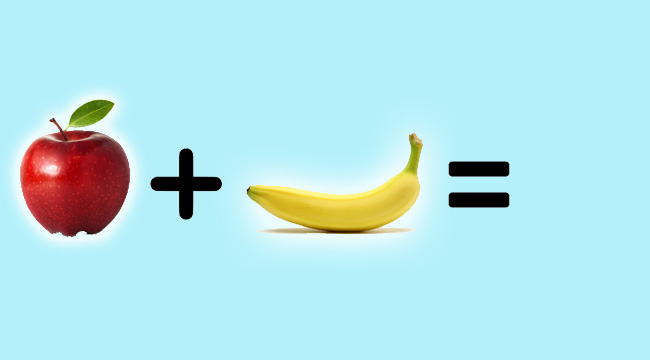
Meet the weapon of your destruction. No, it’s not a gun, or a knife, or any number of traditionally used psychoactive substances that could turn someone’s mind into a quivering bowl of warmed-over pink Jello. No, what will end your relationship, drive you to set fire to your workplace (all the people inside are so wrong) and cut off all your friends (before moving to the woods to live out the rest of your life as a sasquatch impersonator) is a simple little math puzzle. For children. It’s even got ap-ap-ap-apples and bananas. (Sing that in the Barney voice just to remind yourself that this is something toddlers will be working on in pre-k.)
The premise of the puzzle above is deceptively simple. You attach a numerical value to fruit (apples, bananas, and coconuts, in this case) and then simply try to understand what those numerical values are. For instance, if an apple plus an apple plus an apple equals thirty, what’s the value of a single apple. How about this: If we assume an apple is equal to 10, what is the numerical value of two bushels of bananas if adding them to an apple makes 18. Huh? What? (The answer is that a bushel of bananas equals 4.)
The puzzle:
This is driving Facebook crazy today … pic.twitter.com/xGd9a7cRLZ
— A Dark Bxtch (@_aquemini) January 31, 2016
Here’s where the problem lies. Check out the last equation and see if you can solve it. If a bushel of bananas (4) minus two coconut halves equals two, then what is the sum of a coconut half, an apple, and a banana? Is it 14 or is it 16? More importantly, why are we arguing about fruit when we could be eating it?
SPOILER ALERT: HERE COMES THE ANSWER!
Here’s how Mashable describes the thinking of people who can’t decide what the hell is going on:
Some believe that if a pair of coconut halves equals two, then a single coconut half must equal one. Similarly, they believe that if a bundle of four bananas equals four, then a bundle of three must equal three, leaving a final answer of 14.
Others believe that the coconut image always equals two, while the bundle of bananas image always equals four, regardless of changes in illustration. By this thinking, the answer is 16.
Is this puzzle a little unfair? Sure, but that might be because we’re putting too much thought into it. If it was being used to teach children, you bet it would be all about how many coconut halves and how many bananas are in each bushel (suggesting then that one banana is equal to one coconut half in order to teach kids the importance of being vigilant even in the presence of fruit, which is supposed to be safe!), but here we are trying to determine whether the number of coconut halves remains the same regardless of how they’re pictured (very philosophical!). It’s The Dress all over again, and some families are still not over the fallout that caused.
What do you think? 14 or 16? And what does it mean about my math skills that the first time I saw this thing, I wisely nodded my head, quietly uttered “15,” and didn’t even consider any of these views? (If your answer was also 15, just tell people you were looking at this puzzle instead.)
Want an even harder problem? Check this fruit-inspired goliath out. Be warned, there is some straight-up algebra in the comments.
